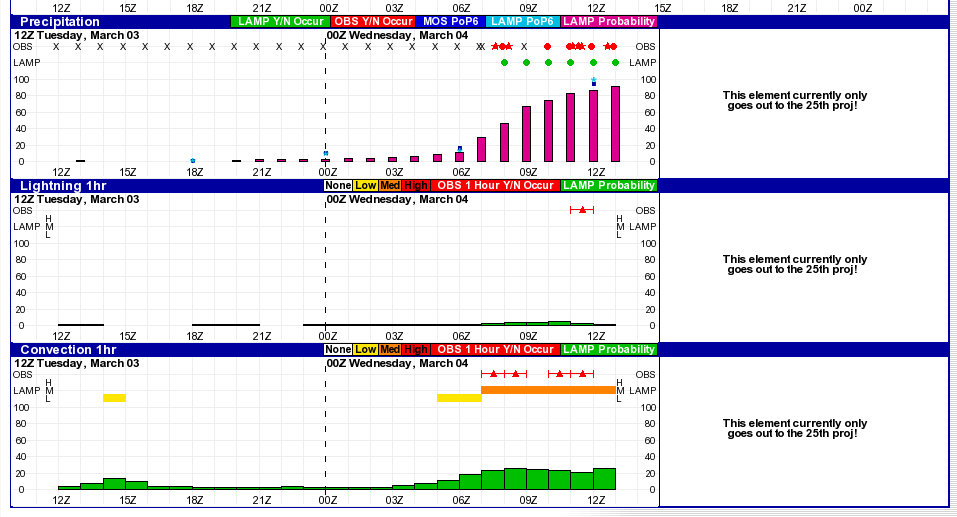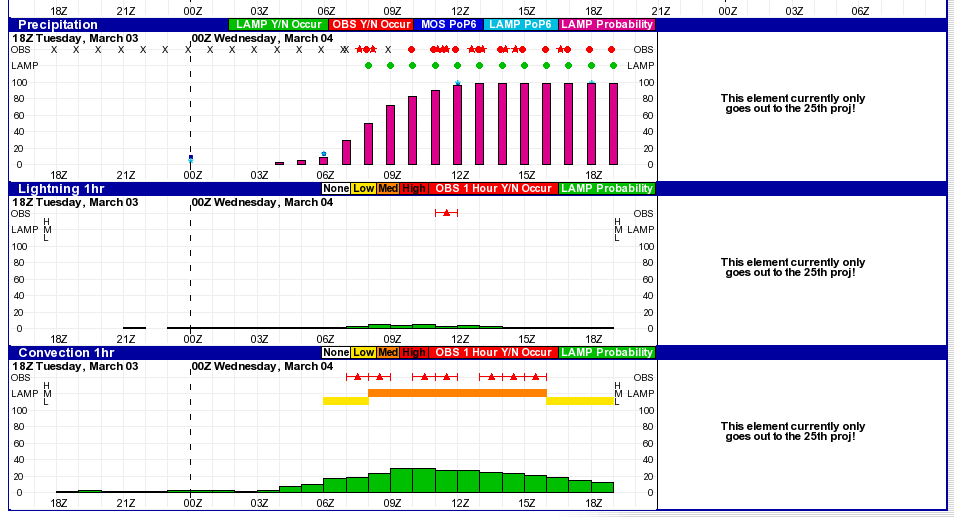Comparing/Contrasting NBM and LAMP Convective Guidance
1-hr NBM Thunder (T01) and LAMP Convection (CP1) Probabilities
I wanted to take a moment to share a case where I have noticed differences between the NBM’s ProbThunder1 (T01) guidance for a point location (KDFW), and the LAMP guidance’s Convective Probabilities (CP1) and CC1 (Y/N). In short, I’m seeing the NBM’s T01 values are MUCH smaller than the LAMP’s CP1 values prior to convective events, and so I’d like to learn more about why they are so different.
Let me start by stating upfront I am NOT saying the NBM’s guidance is no good, and unusable. Instead, I am trying to gain a better understanding of the differences between the two convective-related elements in the two guidance sources, that I fully realize ARE different. To better understand the predictand that was used in developing these guidance packages is likely most of what I need to learn.
As an avid user of LAMP guidance (yes, I’m THAT old, :)) and its hourly update cycle (actually it’s now updated every 30mins, right?) and temporal resolution, I often use LAMP guidance leading up to various upcoming outdoor events (e.g. kid’s soccer games) to assist in event timing (most often precip/thunder onset/cessation), in the 24 to 6 hours before I can begin to monitor radar trends and oher guidance.
As I begin migrating to use NBM guidance more, and LAMP less, I need to learn more about what comparable field(s) in the NBM can provide me with the same sense of comfort about upcoming event timing and characteristics.
So, let’s get started…..
My 2nd son’s high school soccer games are Tues and Fri nights...at 6pm local (00UTC). So, at the Fri, Feb 28th game, there was talk of the upcoming weather for the Tues, Mar 3rd game--valid time=00UTC, Mar4. At that time, 5 days in advance, it looked like a near-certain rainy event, with the only question being if there would also be embedded thunder, which, if it occurred, would cancel the game (they’ll play through plain rain). As you can see in the below WFO FWD ZFP issued Fri late afternoon, it shows PoP12 == 80% for Tuesday, AND a mention of thunder. [ Interestingly, as an aside, when I made the Fri comment that Tuesday’s game would be wet and miserable, my loving wife interjected to the other non-Met parents, that it would be best to wait till about 48 hours beforehand to make such statements of rainfall certainty! ]

Even by the next day, Saturday, the local office began lowering Tuesday PoP12s, and removing mention of thunder for Tuesday daytime.

Fast forward to further into the weekend, and trends began to indicate that the rain MAY come in later on Tuesday than previously shown; and possibly delayed late enough on Tuesday to start after the game’s 00UTC start time. See below local midday Mon ZFP only had PoP12=20% for Tues daytime, and PoP12=80 plus thunder now Tuesday night.

So, while noticing the trend to move the rain till (mostly) AFTER the soccer game, I began to take notice of the chances of convection for Tuesday overnight.
So, first, looking at the now-verified LAMP guidance, making use of the meteorogram views, which conveniently overlay the Observed data with the forecasts, at links like this. If you’ve never before perused these links, they are wonderful to ascertain forecasts during lead-up to impacting weather events--great displays!
This first view is of the meteorogram of the LAMP Precip/Convective forecasts from Tuesday morning, 12UTC. These show, not only how the chance of rain/thunder is near ZERO for 00UTC game time, but also show the hourly thunder probabilities valid 21 to 24 hours in advance of occurrence being in the 20-25 range. Note as well, the red triangle markings, indicating the hours at which thunder was observed at KDFW, which overlays rather nicely with both the CP1 probabilities and the CC1 L and M explicit Y/N values.

As the first comparison, the best I could do was grab the NBM v3.2 text NBH bulletin for KDFW from 7 hours later--19UTC run. In the image, you can see not only that P01 (hourly pops) values are near zero for the 00UTC game time, but note how the NBM’s T01 (hourly prob of thunder) values only top out in the single digits, around 7% for 09UTC--a time at which thunder was Observed at KDFW.

Moving forward to the meteorogram view of the 18UTC LAMP guidance, one can see the hourly CP1 values peaking up near 30% for the 09-12UTC hours, when chances were greatest, and mostly observed.

If we step forward and view both 00 and 06UTC runs from the NBM and note the T01 values, we can see that although the max values match with the time of observed thunder quite well, the values still only top out in the single digits.


The NBM P01 and Q01 appear to be quite good, but the T01 values are low.
So, that is the gist of my wondering--what IS the T01 variable in the NBM, and why is it so low, especially as compared to an older guidance source like LAMP?
I’ll toss in both a meteorogram (00 and 06UTC) and text (0030 and 0630UTC) views from LAMP to show the near-40 values in CP1. Note: This was a rather non-certain case for thunder, so to achieve 40% was probably about as good a forecast as could be mustered from the LAMP inputs.




Before I close, I wanted to toss in just a few more visuals. The first two are from the newly-unveiled WAVE 1D viewer (apparently funded via JTTI) that displays NBM output at thousands of point locations around the country.
The first image is showing NBM forecasts from the 01UTC, Mar 01 run. Displayed are both 6-hr PQPF values and 12-hr Thunder (T12), revealing that several days in advance, there was certainly a rain event upcoming, and indications portions of it would possibly be convective, with the peak T12 value ~30% just after 00UTC Mar 4th, when thunder was observed.

Next, we move to the Mar 3, 13UTC run, and show the T12 values peaking at the correct time to match the 06-12UTC observed thunder at KDFW, but only reaching less than 20% in any TWELVE hour period.

So, to summarize: What does the T01 variable in the NBM forecast, that caused its values to be so low when Thunder was Observed? Is it not a fair comparison to look at NBM's T01 against the LAMP's CP1 forecasts? Are the predictands the same for each?
Thanks for reading, and have a great LAMP and NBM-filled March 2020.
Jack